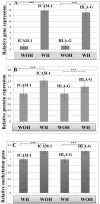Effect of bisphenol A on alterations of ICAM-1 and HLA-G genes expression and DNA methylation profiles in cumulus cells of infertile women with poor response to ovarian stimulation
- PMID: 33953208
- PMCID: PMC8099902
- DOI: 10.1038/s41598-021-87175-1
Effect of bisphenol A on alterations of ICAM-1 and HLA-G genes expression and DNA methylation profiles in cumulus cells of infertile women with poor response to ovarian stimulation
Abstract
This study aimed to investigate the relationship between follicular fluid Bisphenol A (BPA) concentrations with alterations of ICAM-1 and HLA-G genes and proteins expression as well as methylation profiles in the cumulus cells of poor ovarian response (POR) women based on their healthy lifestyle habit. Eighty women under the age of 35 were divided into two groups: 1-POR without using plastic containers (n = 40) and 2-POR with using plastic containers (n = 40). The ICAM-1 and HLA-G genes and protein expressions were examined by the quantitative PCR and western blotting technique. The methylation pattern was investigated by the methylation-specific PCR. Total BPA in follicular fluid was measured with high-performance liquid chromatography technique and the detection limit was 1.14 ng/ml. ICAM-1 and HLA-G genes were differentially expressed between the two groups studied. ICAM-1, HLA-G genes, and protein expressions in group 1 were up-regulated compared to the second group (P < 0.05). While DNA methylation status in group 1 were decreased compared to the other group (P < 0.05). The concentration of BPA in the follicular fluid of group 1 was lower compared to the second group (P < 0.05). The oocyte quality and clinical pregnancy ratio showed significantly higher in group 1 than in the other ones (P < 0.05). The alteration of ICAM-1 and HLA-G gene expressions in POR women is probably related to BPA concentration. As a result Lifestyle habits may also affect the methylation pattern and protein levels in the cumulus cells of POR women. Additionally, lifestyle habits may be considered as a marker for ovulation, oocyte maturation, preimplantation, and clinical pregnancy process.
Conflict of interest statement
The authors declare no competing interests.
Figures



Similar articles
-
Interference of Bisphenol A on Cumulus Cells Development and Number of Retrieved Mature Oocytes in Unexpected Poor Ovarian Response Women: A Prospective Cohort Study.Cell J. 2024 May 7;26(4):267-275. doi: 10.22074/cellj.2024.2020628.1488. Cell J. 2024. PMID: 38736411
-
Bisphenol-A exposure and gene expression in human luteinized membrana granulosa cells in vitro.Hum Reprod. 2017 Feb;32(2):409-417. doi: 10.1093/humrep/dew316. Epub 2016 Dec 15. Hum Reprod. 2017. PMID: 27979917 Free PMC article.
-
Expression of ADR-α1, 2 and ADR-β2 in cumulus cell culture of infertile women with polycystic ovary syndrome and poor responder who are a candidate for IVF: the novel strategic role of clonidine in this expression.J Recept Signal Transduct Res. 2021 Jun;41(3):263-272. doi: 10.1080/10799893.2020.1806320. Epub 2020 Sep 2. J Recept Signal Transduct Res. 2021. PMID: 32878560
-
Bisphenol A alters oocyte maturation by prematurely closing gap junctions in the cumulus cell-oocyte complex.Toxicol Appl Pharmacol. 2018 Apr 1;344:13-22. doi: 10.1016/j.taap.2018.02.011. Epub 2018 Feb 16. Toxicol Appl Pharmacol. 2018. PMID: 29458137
-
The transcriptome of follicular cells: biological insights and clinical implications for the treatment of infertility.Hum Reprod Update. 2014 Jan-Feb;20(1):1-11. doi: 10.1093/humupd/dmt044. Epub 2013 Sep 29. Hum Reprod Update. 2014. PMID: 24082041 Free PMC article. Review.
Cited by
-
Transcription factor occupancy limits DNA methylation and determines ICAM1 expression in breast cancer.Acta Biochim Biophys Sin (Shanghai). 2025 Jan 8;57(5):818-833. doi: 10.3724/abbs.2024237. Acta Biochim Biophys Sin (Shanghai). 2025. PMID: 40230289 Free PMC article.
-
Gene expression and demographic analyses in women with the poor ovarian response: a computational approach.J Assist Reprod Genet. 2023 Nov;40(11):2627-2638. doi: 10.1007/s10815-023-02919-4. Epub 2023 Aug 29. J Assist Reprod Genet. 2023. PMID: 37642817 Free PMC article.
-
The deleterious effect of bisphenol S on early embryo development of mice.Hormones (Athens). 2025 Jun;24(2):533-542. doi: 10.1007/s42000-025-00638-2. Epub 2025 Mar 4. Hormones (Athens). 2025. PMID: 40032781 Free PMC article.
-
The Effect of Bisphenol A on the IVF Outcomes Depending on the Polymorphism of the Detoxification System Genes.J Pers Med. 2021 Oct 26;11(11):1091. doi: 10.3390/jpm11111091. J Pers Med. 2021. PMID: 34834443 Free PMC article.
-
Impact of Bisphenol A and its alternatives on oocyte health: a scoping review.Hum Reprod Update. 2024 Dec 1;30(6):653-691. doi: 10.1093/humupd/dmae025. Hum Reprod Update. 2024. PMID: 39277428 Free PMC article.
References
-
- Ferraretti A-P, Marca A, Fauser B-C, Tarlatzis B, Nargund G, Gianaroli L. ESHRE working group on Poor Ovarian Response. Definition ESHRE consensus on the definition of ‘poor response’ to ovarian stimulation forin vitro fertilization: The Bologna criteria. Hum. Reprod. 2011;26:1616–1624. doi: 10.1093/humrep/der092. - DOI - PubMed
-
- Pandian Z, McTavish A-R, Aucott L, Hamilton P-L, Bhattacharya S. View authors' declarations of interest Interventions for ‘poor responders’ to controlled ovarian hyper stimulation (COH) in in-vitro fertilisation (IVF) Cochrane Database Syst. Rev. 2010;20(1):CD004379. - PubMed
Publication types
MeSH terms
Substances
LinkOut - more resources
Full Text Sources
Medical
Research Materials
Miscellaneous

